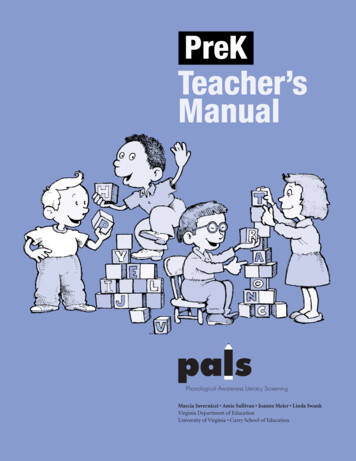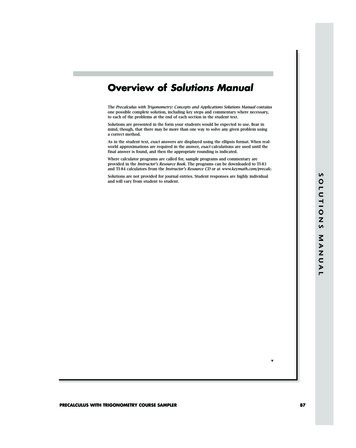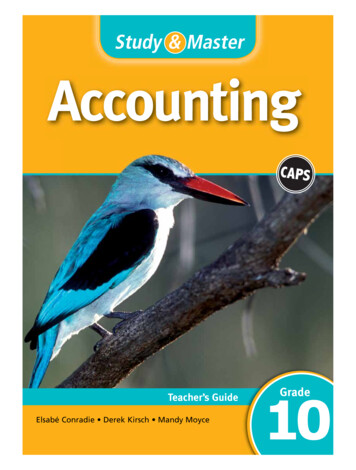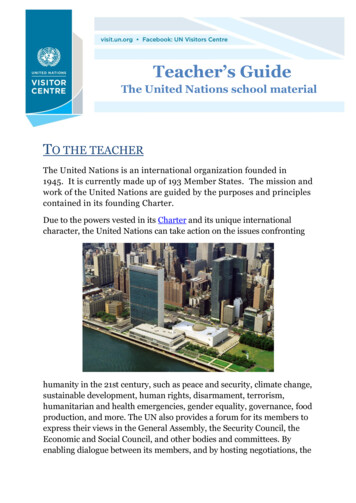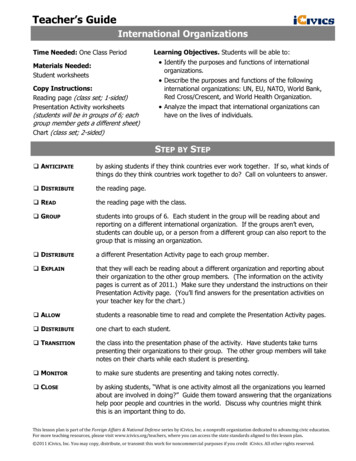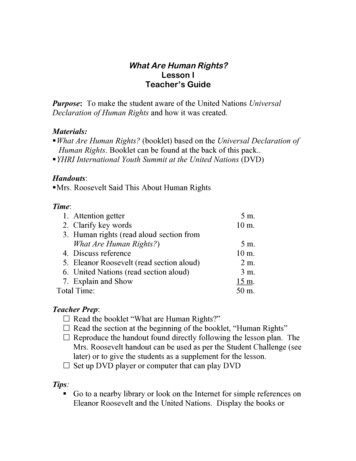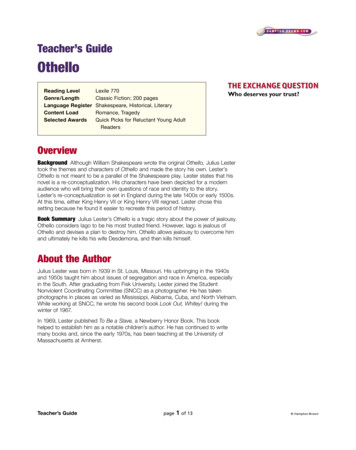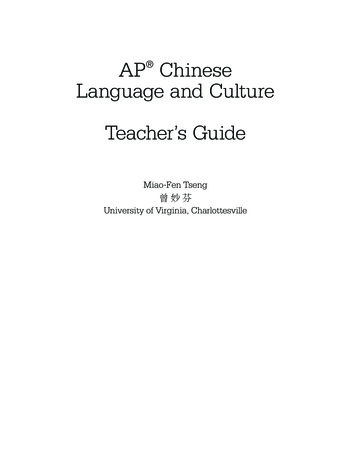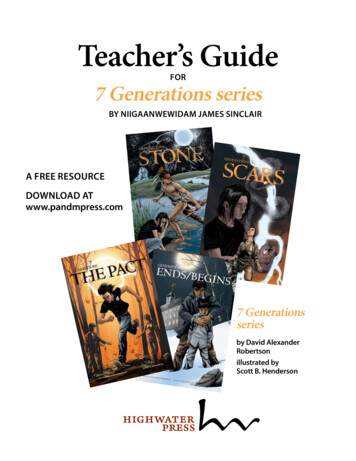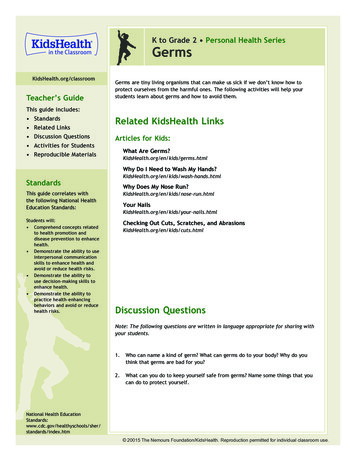
Transcription
K to Grade 2 Personal Health SeriesGermsKidsHealth.org/classroomTeacher’s GuideGerms are tiny living organisms that can make us sick if we don’t know how toprotect ourselves from the harmful ones. The following activities will help yourstudents learn about germs and how to avoid them.This guide includes: Standards Related Links Discussion Questions Activities for StudentsRelated KidsHealth LinksArticles for Kids:What Are Germs? Reproducible MaterialsKidsHealth.org/en/kids/germs.htmlWhy Do I Need to Wash My rdsWhy Does My Nose Run?This guide correlates withthe following National HealthEducation ents will: Comprehend concepts relatedto health promotion anddisease prevention to enhancehealth. Demonstrate the ability to useinterpersonal communicationskills to enhance health andavoid or reduce health risks. Demonstrate the ability touse decision-making skills toenhance health. Demonstrate the ability topractice health-enhancingbehaviors and avoid or reducehealth risks.Checking Out Cuts, Scratches, and AbrasionsYour lth.org/en/kids/cuts.htmlDiscussion QuestionsNote: The following questions are written in language appropriate for sharing withyour students.1.Who can name a kind of germ? What can germs do to your body? Why do youthink that germs are bad for you?2.What can you do to keep yourself safe from germs? Name some things that youcan do to protect yourself.National Health /standards/index.htm 20015 The Nemours Foundation/KidsHealth. Reproduction permitted for individual classroom use.
K to Grade 2 Personal Health SeriesGermsActivities for StudentsNote: The following activities are written in language appropriate for sharing with your students.Skin: A Shield Against GermsObjectives:Students will: Demonstrate knowledge of germs and how germs can make people sick Illustrate and describe how skin protects the body from germsMaterials: Computer with Internet access2 applesParing knife2 plates"Skin: A Shield Against Germs" handoutArt supplies (colored pencils, markers, crayons)Class Time:5 minutes a day for 5 daysActivity:Germs are on tables, on the floor, in the air - everywhere. Some even live on your skin. But your skin helps keep youfrom getting sick from germs by blocking them from getting in your body. What could happen to us if we didn’t haveour wonderful skin? Let’s find out by watching these two apples. The first one has a shiny skin protecting the softinside part of the apple. But let’s peel the skin off of this other apple and see what happens to it over the next fewdays. Using your "Skin: A Shield Against Germs" handout, draw what each one looks like over the next 5 days. Whatdo you notice about the two apples each day? How are they alike? How are they different? What do you think mighthappen to each of these apples over time? Do you think they will stay the same as they are today? Why or why not?Extension:Why is it important to wash a cut or scrape on your skin with with soap and water and protect it with a bandage? 2015 The Nemours Foundation/KidsHealth. Reproduction permitted for individual classroom use.
K to Grade 2 Personal Health SeriesGermsWashing My HandsObjectives:Students will: Demonstrate knowledge of germs and what they can do to the bodyObserve what happens to their hands when they playDemonstrate proper hand-washing techniques and explain the importance of washing handsMaterials: Area to play outside or plastic tubs full of dirtMagnifying glassesSoap, sink, paper towelsWashing My Hands handoutArt supplies (colored pencils, markers, crayons)Class Time:30 minutesActivity:All day long, your hands touch things that have lots of tiny germs all over them. Today, we’re going to take a closelook at our hands after you’ve had some fun playing and we’re going to learn what we can do to keep our handsclean. Let’s go outside and dig in the dirt for a few minutes. Once we’re back inside, we’ll look at our hands with ourmagnifying glasses. What do you think you’ll see?[After playing outside.]How do they look? Do you think it would be a good idea to go eat lunch right now? What could happen if you did that?The best way to get all those germs off your hands is to wash them. But does it matter how you wash your hands?Let’s find out. Half the class will wash their hands with just water. The other half will use soap and water. Then we’lllook at our hands under the magnifying glasses again. What do you think you’ll find? Now, color the pictures on your"Washing My Hands" handout and number them to put them in the right order.Reproducible MaterialsHandout: Skin: A Shield Against iene/germs handout1.pdfHandout: Washing My iene/germs handout2.pdfQuiz: iene/germs quiz.pdfAnswer Key: iene/germs quiz answers.pdfKidsHealth.org is devoted to providing the latest children’s health information. The site, which is widelyrecommended by educators, libraries, and school associations, has received the “Teachers’ Choice Awardfor the Family” and the prestigious Pirelli Award for “Best Educational Media for Students.” KidsHealth comesfrom the nonprofit Nemours Foundation. Check out www.KidsHealth.org to see the latest additions! 2015 The Nemours Foundation/KidsHealth. Reproduction permitted for individual classroom use.
Personal Health SeriesGermsName:Date:Skin: A Shield Against GermsInstructions: Each day, draw a picture of what the two apples look like.DayWhole ApplePeeled Apple12345 2015 The Nemours Foundation/KidsHealth. Reproduction permitted for individual classroom use.
Personal Health SeriesGermsName:Date:Washing My HandsInstructions: Color the pictures and number each one so they’re in the right order. 2015 The Nemours Foundation/KidsHealth. Reproduction permitted for individual classroom use.
Personal Health SeriesGermsName:Date:Quiz1.Germs are so small, you need one of these to see them:a) Stethoscopeb) Telescopec) Microscope2.If germs get inside your body, you could:a) Feel them squirming aroundb) Get sick3.Using soap and water:a) Makes germs smell niceb) Kills germs4.When should you wash your hands?a) After taking a bathb) After going to the bathroomc) After playing outsided) While you are sleepinge) Before eating5.People should remember to cough or sneeze into their elbow or a tissue. Circlewhere you should put a tissue after you cough, sneeze, or blow your nose: 2015 The Nemours Foundation/KidsHealth. Reproduction permitted for individual classroom use.
Personal Health SeriesGermsName:Date:Quiz1.Germs are so small, you need one of these to see them:a) Stethoscopeb) Telescopec) Microscope2.If germs get inside your body, you could:a) Feel them squirming aroundb) Get sick3.Using soap and water:a) Makes germs smell niceb) Kills germs4.When should you wash your hands?a) After taking a bathb) After going to the bathroomc) After playing outsided) While you are sleepinge) Before eating5.People should remember to cough or sneeze into their elbow or a tissue. Circlewhere you should put a tissue after you cough, sneeze, or blow your nose: 2015 The Nemours Foundation/KidsHealth. Reproduction permitted for individual classroom use.
5 minutes a day for 5 days Activity: Germs are on tables, on the floor, in the air - everywhere. Some even live on your skin. But your skin helps keep you from getting sick from germs by blocking them from getting in your body. What could happen to us if we didn’t have our wonderful skin? Let’s find out by watching these two apples. The first one has a shiny skin protecting the soft inside .
